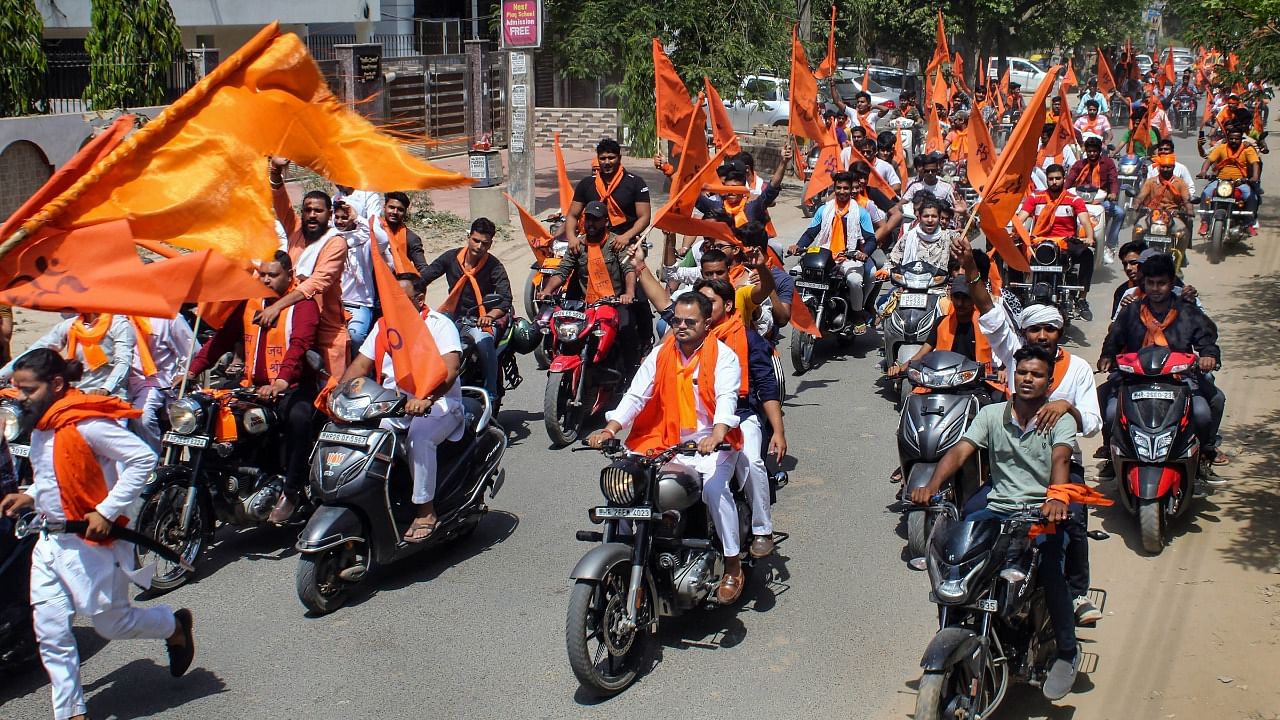
Why is there intense Hindutva mobilisation across diverse locations in India at this point in time? Have we suddenly discovered our Hindutva soul and feel compelled to announce it loudly to the world, especially in Muslim neighbourhoods or streets where there are mosques on which some Indians now apparently have an overpowering desire to hoist saffron flags? Is the "true nature" of India now being revealed in the myriad tableaux of obnoxious processions, where abuses are mixed with religious/identity slogans.
Is this what we are, and has the current national ruling dispensation just helped us realise it?
I believe we are at that point in our history where the tree of life that was India is being violently shaken by the mob so that all the low hanging fruit falls, some branches break off, and perhaps the entire plant gets uprooted.
It's a shakedown designed to instil fear not just in minorities but in all institutions that are supposed to safeguard the Constitution. It is part of a long process, and the aim also is to create a psychological state that scares opposition forces and makes the bureaucracy, Election Commission and judiciary more pliant.
There is a shock and awe aspect to what is unfolding.
Also Read — Hindu Sena puts up posters near JNU main gate, warns of 'stringent steps if saffron insulted'
Beyond the theories of the unfinished business of Partition and creating a Hindu Rashtra, there is a more banal aspect to what is happening. The national government has failed to create any jobs or employment opportunities. The small and medium sector of the economy, one of the biggest employers of Indian labour, has tottered since the demonetisation in 2016 and has faced subsequent blows such as the imposition of the GST and lockdowns.
There is a flight of capital outside India even as some data sets show a section of the rich getting richer and the poor poorer. We are selling petrol and diesel at some of the highest rates globally, and inflation is through the roof. With one foot inside our borders, China is a superpower; while we are diminished, our one super-power of being a moral power has evaporated.
Simultaneously, what has also happened is that the BJP is the richest party in India's history and gets richer before every election when electoral bonds are issued, mostly in the national party's favour.
While opaqueness in political funding keeps the public clueless about corporate and political quid pro quos, the ruthlessness of the Delhi regime is unmatched, and it works on an open design to keep other political parties starved of funds through the Enforcement Directorate and income tax raids. It is only those political parties that are in power in states that seem to have the capacity to fight back, but the onslaught is relentless, as seen in the spate of arrests of leaders that are part of the ruling coalition in Maharashtra, a state where the BJP believes it was unfairly done out of power.
That's the backdrop to what is unfolding. For despite all the power, money and clout at its disposal, the BJP has not been able to deliver on any promise of real economic growth or well-being. Giving out rations as a lifeline is the treatment of the disease of endemic poverty and can hardly be a substitute for a genuine journey up the economic ladder. In this scenario, apparently, the only thing left to do is to let hell break loose.
This is precisely what is happening in India today. The thinking appears to be that a scorched earth policy would excite and radicalise a section of the youth and keep them engaged in perpetual warfare directed at minorities. This serves many purposes—creates a grand diversion from real bread and butter issues, asserts the larger Hindu First ideology of the BJP and Sangh Parivar, and gives a purpose to otherwise unemployed youth.
It's not possible to come up with exact data points on this, but there are resources available to recruit youth into one of the many Hindu front organisations that have mushroomed. Make no mistake, all the young men now seen brandishing swords and flags, shouting slogans and abuses, all the hard work of mobilisation for this cause, are being compensated for their efforts. It's an informal sector now, and similar to cash doled out to pay for the costs during an election. The young men would get a purpose and some loose cash to be available for deployment in processions and agitations. They have loosely become part of a militia, and according to media reports, the participants in the Hanuman Jayanti procession that led to clashes in the national capital were brandishing weapons such as pistols and shotguns.
There is, therefore, an ideological goal, a political plan and an economic chaos theory at work here. The plan is clearly at play in Karnataka, which has elections next year. Should this shakedown approach of mobilisation succeed electorally, this will be applied to further southern states beyond the already proven utility in the Hindi heartland and Gujarat.
But beyond the electoral calculus, it's important to state that this season of hate and violence represents a crisis not just for Indian Muslims. It's an inflexion point for India's majority community, whose children are being offered no jobs but a path of violence and hate, and their festivals are being appropriated for a radicalised version of the faith.
(Saba Naqvi is a journalist and author.)
Disclaimer: The views expressed above are the author's own. They do not necessarily reflect the views of DH.
Watch the latest DH Videos here: